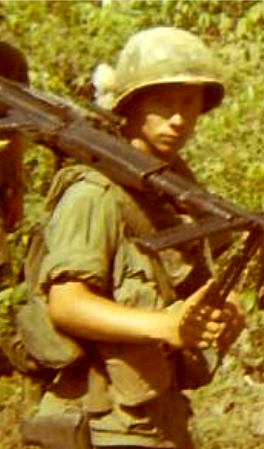
Ray Ashnault and his M-60 and bi-pod. One of his many medals was the Sharpshooters Badge on automatic rifle bar.
Meet SP4 Raymond J. Ashnault U.S. Army, One of Cranford’s 86
By Don Sweeney with research by Stu Rosenthal, proofreading by Vic Bary and Pat Pavlak
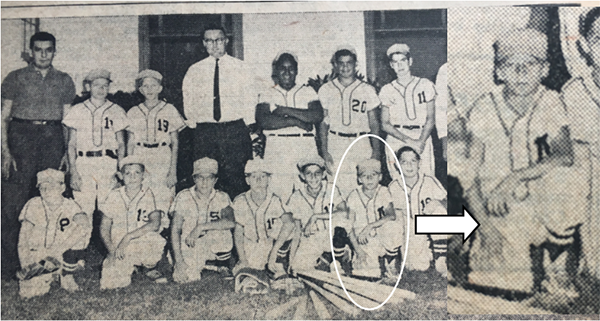
Ray was the smallest, but most athletically gifted player on The Pirates in the 1959 Cranford Little League World Series. He handled the clean-up position as well as giving a commanding performance as pitcher and second baseman. Ray is mentioned in Chronicle baseball articles from 1957 through 1961.
A group of young teenagers has gathered on a vacant lot adjacent to 3 Garden Place, the home of the Ashnault family. A sandlot baseball game was underway, a common sight in 1962. Paul Patterson remembers the friendly competition the kids enjoyed every weekend through most of their childhood. As fourteen-year-old Ray Ashnault approached the plate, all the outfielders backed up to the fence. Ray was a small kid, but he could wallop a baseball. Paul told us that Ray hit the ball over the fence nearly every time he went to bat. Sometimes he would hit the house in the distance and a couple times would hit and break a window. His other talents on the field were more than adequate, but it was with a bat in his hand that Ray was a master.
Cranford Chronicle articles from 1957 to 1960, that our researchers found tell of Ray’s talents on the baseball diamond during the Little League all-star games and world series for the tri-county league. Reports of clutch hits to win games and long balls that cleared the bases tell the story of his glory days as a Little League slugger. One article made an observation that seemed to describe Ray Ashnault’s life. “In the Pirate lineup Ray Ashnault handled the keystone position (second base). He was the smallest boy on the team but can cover a good deal of the ground.”
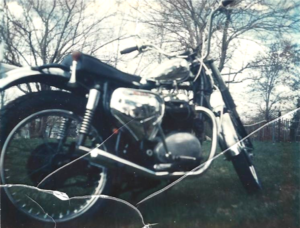
Ray rode many miles with his brother John on this BSA motorcycle. This photo shows the bike in the style and condition that John remembers from those rides.
You would think with talent like this he would have certainly been corralled by organized baseball at the next level and would have had an illustrious high school career. That was not his plan. Ray had a passion for cars and motorcycles and the motors that made them fast. His friends say Ray was a “motor head”. While he continued to play in the sandlot and would enjoy a ‘good catch” with a friend occasionally, he could be found in the garage behind his home on Garden Place (called “the barn”). There he worked on his BSA motorcycle, that he rebuilt from scrap, or one of many old cars whenever time allowed. Motors were Ray Ashnault’s passion. One story told to us by Fred Hayeck created a visual picture of his meticulous nature in his mechanical projects. Ray had an Oldsmobile from the early 50s that he was restoring. Fred remembers Ray wet sanding the hood for days and days, far past what would be considered necessary. When Fred questioned Ray as to why he kept sanding, Ray said it must be perfect. Fred continued to fill in the personal profile of Ray by telling me about Ray’s other pastime of playing the drums and playing them hard. He noted that while Ray had a small frame, he was physically developed to a high degree through weight training. The pictures that we gathered bear that out.
Ray was born on April 17, 1948, attended St. Michael’s School and later graduated from Cranford High School in the class of 1966. He put his mechanical abilities to work at Singer in Elizabeth, a leading American manufacturing company famous for its namesake sewing machines as well as government contract manufacturing for American war needs. He would only work there for a year, feeling the need to serve his country. The conflict in Vietnam was at its height. Ray told his mom that there was work to be done there, and he wanted to be part of it. He enlisted in the army on June 24th, 1968 and was sent to Fort Benning, Georgia for his basic training and Fort McClellan, Alabama for advanced training and then sent to Fort Lewis in Tacoma Washington before he was transported by jet to Vietnam on December 2, 1968. We were lucky to be able to speak at length with Harold Hovater from his home in Muscle Shoals, Alabama. Harold travelled to Vietnam on the same plane with Ray and was paired with him for the next six months. His accounts of their brother-like relationship would give us the best understanding of the man that Ray Ashnault was.
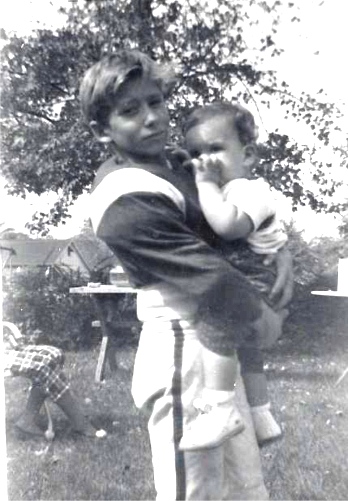
Ray, dressed in his football uniform, holding his little brother John. John was only 8 when Ray volunteered to serve.
Of the nearly 100 soldiers being delivered to Vietnam on that commercial airliner only Ray and Harold were selected to join Company A 1st Battalion, 8th Cavalry, 1st Cavalry Division (Air mobile). They were issued their gear at the Headquarters Company and were put on a helicopter and transported to their new unit in the battle theater. Alpha company was positioned on a peninsula on a rice paddy dike. The helicopter was unable to set down due to the soft ground, so it hovered about 12-15 feet above the rice paddy, where the men were ordered to jump with their 70 pounds of gear. Harold told of their landing as they plunged into mud that went to their waist as they watched their helicopter fade into the distance. It was quite the introduction to their new life in Vietnam for their scheduled one-year tour of duty for these two twenty-year-old young men.
Harold was picked for a machine gun squad which separated him and Ray for two weeks. Very quickly he recommended his friend and Ray was brought into his squad. A machine gun squad consisted of 5 men who carried two M-60 machine guns. This was a huge gun weighing 24 pounds (90 pounds with its ammo). Two men were designated to carry the guns and the other three men carried M-16 rifles, extra ammo or an M79 grenade launcher. Harold, a big guy, was selected to carry one of the M-60s and Ray Ashnault, the smallest man in the squad, volunteered to carry the other. Ray was a strong guy, but the thought of a man of 160 pounds, carrying a 90-pound machine gun setup and his own personal gear of another 70 pounds was quite a task in 100 to 110-degree heat. Harold said he handled it fine. The portraits we have of Ray in the battle field show the bandoleers of the 60-caliber ammunition draped around his neck. The M-60 was known as “The Pig” because it sounded like a grunting barnyard hog. It could fire up to 650 rounds per minute and was made famous in the movies as Rambo’s weapon of choice.
I asked Harold if he could share any memories of Ray and the time that he spent with him. He told me of the regular arrivals of care packages from home his and Ray’s family would send them every month. They seemed to always arrive two weeks apart. He and Ray would always open them together and shared them exclusively with each other. Except for once, when a package arrived that contained a banana nut birthday cake (an Ashnault family birthday tradition) along with candles, noisemakers and decorations sent by Ray’s mom to help them celebrate his 21st birthday. For this package they let the whole squad join in (see picture). Harold went on to tell me that he didn’t have a brother, but if he did, he would have hoped he’d be just like Ray. He said Ray treated everyone he met with the upmost respect, no matter who they were.
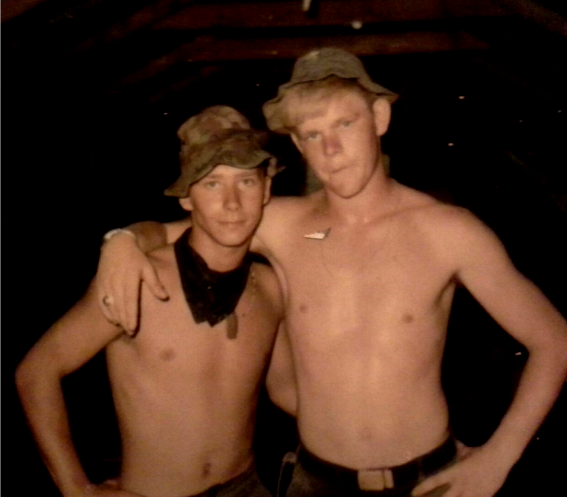
Ray with Harold Hovater from Muscle Shoals, Alabama. Both were 20 years old when they served together for six months in Vietnam. Our interview with Harold helped us understand the man behind the engraved name on our monument.
In my interview with Harold I was hoping to get first hand accounts of the episodes that led to the presentation of Ray’s Bronze Star with a V device for Valor. I was told that Harold was with him in battle that day. I brought it up, hoping he would be able to talk about it. I didn’t want to open a memory that was uncomfortable for him. By now I had learned that these memories are not easily talked about. So, I asked, “Harold, I heard you might have been with Ray the day that he earned the Bronze Star for Valor.” He paused. “Yes” he said, “we both won a Bronze Star that day.” “Would you be able to share the circumstances with me?” He said “yes I’ll try “. What followed was the most touching moment of all the interviews that I have conducted in the two years that I have been doing this.
Harold continued, “It was May 30th, 1968. Our commanding officer came in to speak to us. He said he wanted us to write home and tell our family and loved ones that we loved them and that they shouldn’t worry about us. He went on to say that no matter what happens in the next few days he wanted us to know that he thought the world of us.” Harold said that was very scary for them all. The next morning their platoon was to head out on a search and destroy mission. There was reportedly a Viet Cong supply depot that needed to be removed. Our research uncovered a military report that spoke of possible nerve gas from Communist China that was suspected to have been part of the supplies held there. It made us understand the importance of the mission to search and destroy this encampment which no American or South Vietnamese soldier had seen in four years or maybe ever.
On the morning of June 1st, Alpha Company was dropped in by Huey helicopters north of Xuan Loc, along The Dong Nai River in Long Khanh province. They discovered the described supply area. It contained tonnage of canned mackerel, rice and canned milk. It seemed that the compound had been deserted by the enemy. They also found several other buildings containing munitions and sampan boats. After some buildings and boats were demolished with C-4 explosives, it was decided much more C-4 would be needed as well as helicopters to move the mass quantity of provisions. They would set up camp by the nearby river and return in the morning. Harold and Ray’s squad would be second to attempt the re-entry of the supply complex. As the first platoon approached the complex carrying C-4 explosives, they were attacked with rocket propelled grenades. Four men were hit including Ray and Harold’s platoon leader, Sergeant Lyman Conrad Bach, who was killed. Two platoons, approximately 60 -80 Viet Cong, had returned to the depot overnight. Ray and Harold quickly set up their M-60 machine guns eight yards apart and started to cover the platoon with constant fire. Harold said that they kept glancing at each other throughout the firefight. He said, “Ray was awesome, just doing what he was supposed to be doing.” Alternately they covered each other with fire as the other went forward and pulled the wounded back to safety. The fierce fighting went on constantly for two days. The night of the 2nd the sounds of digging could be heard across enemy lines throughout the night. It seemed that they were digging in with defensive fox holes for an all-out assault in the morning. When morning came “a mad minute” of fire was ordered. There was no return fire. The enemy had moved out in the middle of the night and had crossed the river. The battle was over. It seems that the digging noises were the Viet Cong burying their dead. Harold said he thought that neither he nor Ray would make it through the battle alive. It was their first real battle and they thought it might be their last. In all, five members of Ray’s unit were killed, and 3 members of a helicopter crew died when their Huey was shot down while they were assisting the beleaguered unit. Twenty-six soldiers were wounded. Five Bronze Stars with a V device for Valor were earned that day including Harold and Ray’s. On June 3rd during the mopping up, a fresh grave of a Chinese soldier was found and a canister with Chinese lettering was uncovered, believed to be nerve gas.
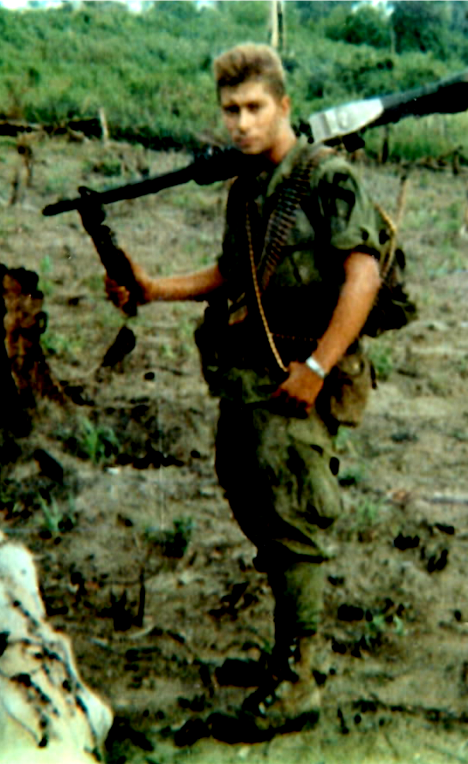
The M-60 could deliver 650 mounds per minute. Made famous in the movies as Rambo’s weapon of choice.
In a letter home shortly after, Ray wrote “How’s everything going? Fine, I hope? I figured by now you heard the news but in case you haven’t, I was awarded a Bronze Star medal. Believe me, I was just doing my job the best I could. I’m no hero, but I’m proud of it, and I’m sure you’ll both be just as proud as I am.”
Three or four times while telling the accounts of the battle, Harold went silent as he regained his composure. I am not sure if he had told that story to many people before this interview. I followed with a question about Ray’s lighter side of being a prankster to break the somber feeling that had taken us both over. I could tell he appreciated it.
Ray’s family tells us that since Ray was a kid, he got a kick out of making people laugh with his pranks. His mother tells a story about twelve-year-old Ray selling raffle tickets for five cents for a grand prize of a “Lincoln”. After the entire family bought in, awaiting to see what he was up to. He drew a winning ticket and awarded a shiny Lincoln penny. Cranford High School legends tell of a time that Ray hooked up a New York radio station to the school PA system, blaring rock music to every classroom in the school. He was said by some to be a “cut up”, always for a laugh and never causing damage or injury, just a harmless prankster. Harold’s answer to my inquiry about any Army pranks was a good one. They had found an immature python in the “boonies”. Ray thought it would be funny if he put it in the sergeant’s tent. He was right, everyone thought it was hysterical and it provided a much-needed laugh. When the sergeant was surprised by the six-foot constrictor, he nearly jumped out of his skin as he ran screaming out of his tent. He said if he ever found who planted it there, he would have them court-martialed. He never found the culprit.
My questioning of Harold moved further into their brother-like relationship. I was hoping Harold would be able to continue with stories through to the end of Ray’s life. That was not to happen. Harold was badly injured on June 19th, just two weeks after the battle that distinguished them both for their heroic actions. He was a victim of a traumatic brain injury. He remembers waking up in a hospital with bandages wrapped tightly around his head. He heard the door open and through the white gauze he could see Ray, who had travelled to see his buddy and make sure he was alright. Harold told Ray that they were sending him back home and that he wished he could stay there with him. It was the last time they saw each other. Harold was shipped to Walter Reed Medical Center in Washington, DC where he had surgery that took much of his memory for over 20 years. It was at a travelling mini Vietnam Wall display in Muscle Shoals that he asked if Ray Ashnault was on the wall. When he saw his name, he broke down and cried. It was the first he heard of Ray’s death.
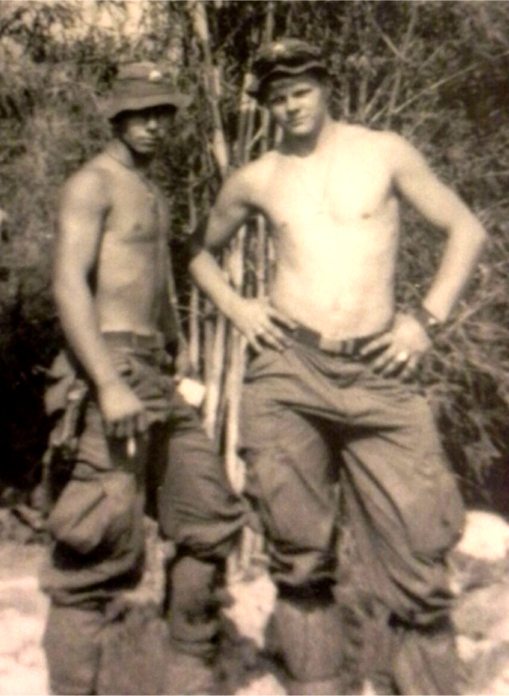
Ray Ashnault and Harold Hovater were inseparable throughout their time together in Vietnam (December 2, – June 16, 1969). This picture of the two of them hangs in Harold’s home to this day.
In the months that followed we know that Ray was injured, receiving a Purple Heart. He was hospitalized, treated and released, anxious to rejoin his unit. We are awaiting additional military records to complete this story. Check Cranford86.org for updates.
On August 19th of 1969 Ray was at the base Headquarters, 3rd Brigade, U.S. 1st Cavalry Division near Quan Loi in Binh Long Province. At 1:33 AM, the base received a ground attack from an unknown sized enemy force using small arms and automatic weapons. The troopers fired back and were supported by artillery, helicopter gunships and tanks from the 11th Armored Calvary Regiment located at the camp. At 2:00 AM, the enemy withdrew, their losses were unknown. During the action, a tragic accident occurred in which a Sheridan tank accidentally fired on an American bunker near the northwest perimeter of the base. Nine troopers were killed and another five wounded. Sadly, and shockingly, after such a courageous tour of duty, Ray Ashnault was among those nine.
In recognition of his entire tour in Vietnam, Ray received additional awards for meritorious service. These included a second Bronze Star and the Air Medal for participation in more than 25 aerial missions over hostile territory in which “his determination to accomplish his mission in spite of inherent hazards, his outstanding degree of professionalism and devotion to duty has brought credit to himself, his organization and the military service”. (text directly from the letter that accompanied his medals). See Cranford86.org for more about his medals.
Back at home Ray was given a funeral with full military honors. His neighbors Fred Hayeck and Carol Hayeck Brown told us of the military guards who stood at the head and foot of Ray at the funeral home. Every fifteen minutes there was an impressive changing of the guard ceremony. Then at the gravesite a 21-gun salute by an honor guard sent from Fort Monmouth concluded the ceremony, one they would never forget.
Interviews of neighbors and friends of Ray were helpful in letting me get to know the person behind the engraved name on our town’s monument. Fred Hayeck and Carol Hayeck Brown, sandlot player Paul Patterson and comrade Harold Hovater all told me of their attachment to Ray and their incredible feeling of loss when they heard of his passing. They shared with me the deep emotion that gripped everyone who knew Ray and the Ashnault family. During the interviews many tears were still being shed, even though fifty years have passed. It reminded me that, while we often speak of the soldier who paid the ultimate price for freedom, what sometimes is missed is the high price for freedom that is paid by all who loved our heroes.
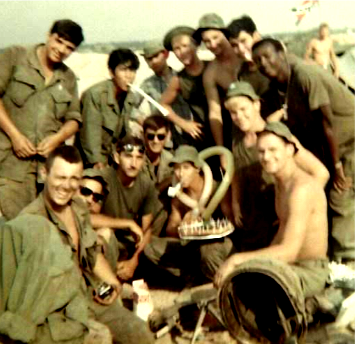
With his platoon comrades and his family’s traditional banana nut birthday cake that was sent over 8500 miles by his mom, complete with noisemakers and balloons.
One of the loved ones left behind was Ray’s younger brother John. He was only eight when Ray went off to war. While he has limited memories of times spent with Ray, ones that he treasures are the rides that he and Ray shared on the classic BSA motorcycle. John’s love of working on motors and riding motorcycles has kept Ray’s memories alive for him. He wrote some touching memories for us in lieu of an emotionally difficult interview. We have printed them in their entirety at Cranford86.org. His closing line wrapped up our story of Ray Ashnault best. “I know in my heart that there are many servicemen who made it home because of my brother’s courageous actions in battle.”
Raymond J. Ashnault lived his entire life as a bigger man than that small frame that he had been endowed with should have allowed. He was a great American patriot and one of our Cranford 86.
The story of Ray Ashnault was previously told briefly as our first Cranford 86 article, sharing space with Joseph Minnock. While the first stories told by our project were done with total respect to the memories of our town’s heroes, they were done without much research. With the skills that we now have, our articles have become much more detailed and fact filled. Our committee therefore decided to revisit the life stories of both Joseph Minnock and Raymond Ashnault. We feel now that we have represented their service to our country more completely. It was our pleasure to do so.
Visit Cranford86.org for more photos and links to our research sources as well as YouTube links to interesting articles and videos. For information about our project or to comment on this article we welcome your inquiries. Email us at info@Cranford86.org or (908) 272-0876. Find us on Facebook at Cranford86.
Ray’s brother John’s memories of his brother
I wish that I remembered more about my brother Ray. I was only 8 years old when he left for basic training. His letters to me were always addressed to “Master John Ashnault”, which I’m sure made me feel very important at the time. In one of the letters he sent me the small tool that was used to open the C-ration cans.
The strongest memory that I have is riding with my brother on his motorcycle. The bike was a BSA from the early 60’s. He bought it from someone, where it had been stored under their front porch in pieces. After making many trips to nearby Circle Cycle for parts, Ray did a beautiful job of restoring it. The bike changed over the years and I would someday like bring it back to the way it was when he and I rode on it together.
Ray was a hunter and he kept his gear in a small area in our basement. I knew better than to touch any of it! I remember him sitting there putting the tips on his arrows. He hunted in Somerville and believe it or not, took the train from Cranford to get there. This was common in those days, young hunters with their licenses on their backs and shotguns broken open taking the train to go hunting. I know he hunted pheasant, because I remember having it for dinner and encountering some birdshot!
I share Ray’s love for motors and have had motorcycles for years. More recently I have been involved with drag racing and what I wouldn’t give to have him out there with me at the track. My father said to me once, “I’d hate to see what came out of that garage if your brother was here to work on it with you”.
It seemed that anything that Ray did, he did meticulously and always gave it his all, whether at home or overseas. I know in my heart that there were many servicemen that made it home from Vietnam because of my brother’s courageous actions in battle. Although I lack so much of the memories, I will always carry tremendous love, respect, and pride for my brother Ray.
YouTube clips
The C-Ration
https://www.youtube.com/watch?v=ZVOIgPrDH7E
Military training film for the M-60 machine gun
https://www.youtube.com/watch?v=esrMpo5I97A
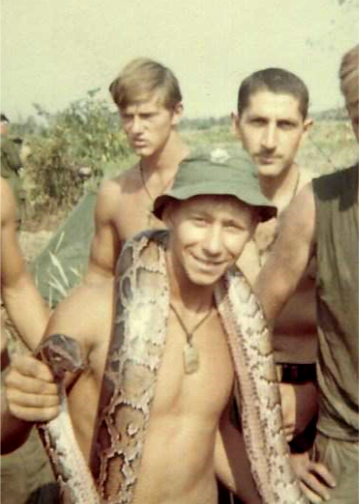
The Burmese Python was a common species in Vietnam. Ray was famous for a prank in which he hid one in his sergeant’s tent.
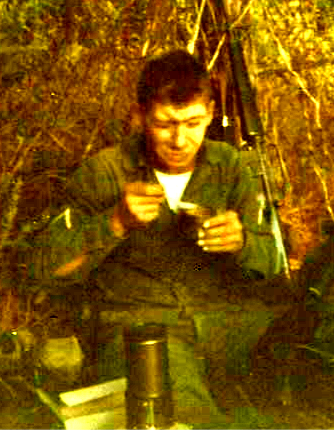
Ray Ashnault “enjoying” a 1969 Vietnam Meal Combat individual “C-Ration”. A wet ration that came many times with a canned spaghetti dinner, crackers, cheese spread, coffee, cream, sugar, a dessert, a can opener, utensils, matches, chiclets, toothbrush, a toothpick and some cigarettes. See the YouTube video on Cranford86.org.
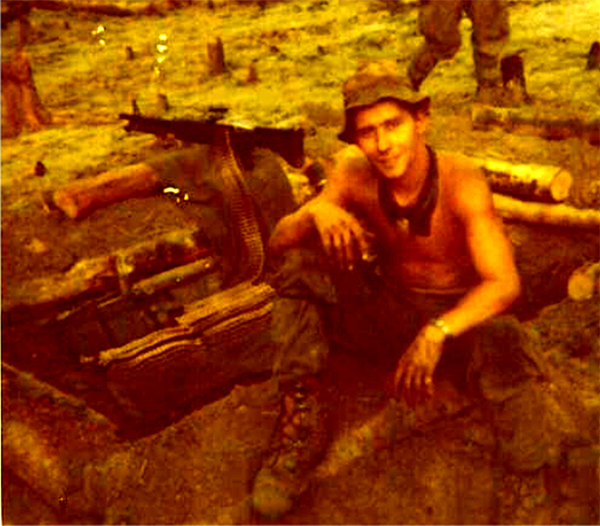
Ray’s meticulous nature can be seen in the way he laid out his ammunition for his M-60 machine gun in and around his foxhole.
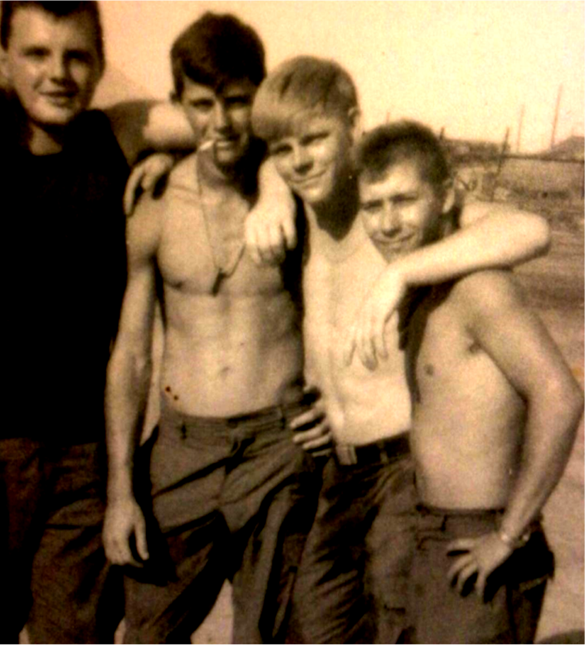
A Band of Brothers in Vietnam, Harold Hovater and Ray Ashnault (3rd and 4th from left) with two unidentified comrades deal with the daily heat of 100-110 degrees.
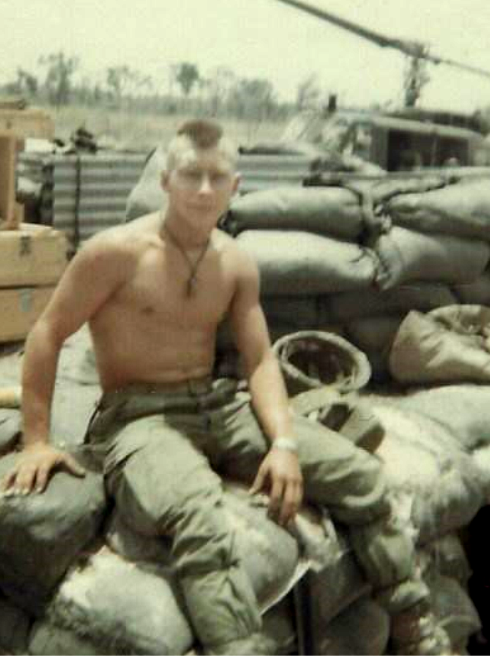
Harold Hovater described Ray Ashnault’s physique as 160 pounds and all muscle. Posing here with the Vietnam Calvary’s horse, the UH-1 Helicopter (the “Huey”), in the background.
